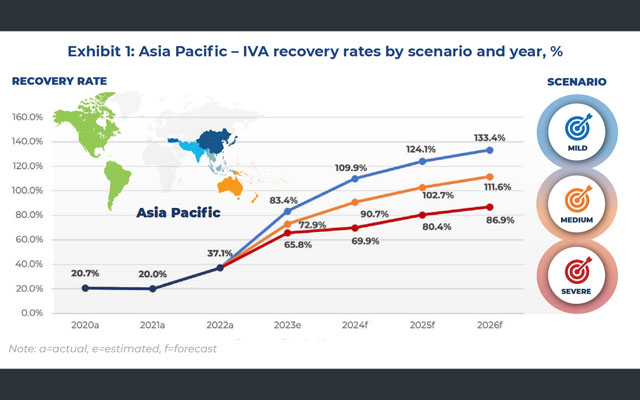PATA’s newly released Asia Pacific Visitor Forecasts report is forecasting a 109.9 per cent recovery of international visitor arrivals (IVAs) by the end of this year under a mild scenario.
Recovery under a medium scenario, however, would only materialise at the end of 2025.

With world events remaining volatile, a severe scenario remains possible; recovery would strengthen more slowly to 2026, and remaining 13 points below the 2019 level by the end of the forecast period.
Across all three scenarios, growth in IVAs into and across Asia-Pacific is predicted to be driven by Asia, the Americas and Europe. Under the medium scenario, those three source regions are predicted to account for almost 92 per cent of all IVAs generated into and across Asia-Pacific in 2024, increasing marginally by 2026.
Under the mild and severe scenarios, those proportions are predicted to differ only very marginally at this aggregate level.
In tracking source markets performance into and across the total Asia-Pacific region, the PATA study ranks China, the US, Hong Kong, South Korea, and Macau as the top five contributors of travellers in descending order.
China outbound numbers are expected to be in the range of 109 million for 2024, with a market share of 17.7 per cent among the top 10 source markets.
In studying IVAs into 22 destinations in Asia alone, PATA forecasts a 107.4 per cent recovery by the end of this year under the mild scenario and 100.4 per cent recovery by end-2025 under the medium scenario. With a conservative lens, full recovery would only materialise after 2026.
Within Asia, the destination sub-regions of North-east Asia and South-east Asia are predicted to receive the majority share of IVAs in 2024 – 52.9 per cent and 31.9 per cent respectively. China will contribute the lion’s share of IVAs into Asia – 105.4 million expected.
In presenting the projections during a webinar on February 7, Haiyan Song, associate dean, School of Hotel and Tourism Management, The Hong Kong Polytechnic University, noted that increased openness and connectivity are the key to North-east Asia’s continued recovery, while South-east Asia would require improvements in intra- and inter-connectivity such as new flight routes and relaxed visa processes.
Look farther ahead, Song said North-east Asia could expect 330 million visitors by the end of 2026, while South-east Asia could receive 157 million along the same timeline – both under the medium scenario.
PATA researchers noted that intra-Asia travel flows are forecasted to remain the backbone of IVAs across Asia, rising from a 76 per cent share of all arrivals in 2024 to almost 79 per cent by the end of 2026.
Fellow webinar speaker, Caroline Bremner, head of travel research at Euromonitor International, shared that rail travel, festivals/leisure events, and museums/cultural sites would attract the most tourism spend in 2024.
Bremner described the year 2024 being a “new growth era” for travel amid challenges of an economic slowdown, characterised by cities thriving on the back of culturally immersive experiences, sustainable developments and digital transformation, as well as resilience in luxury travel.




















